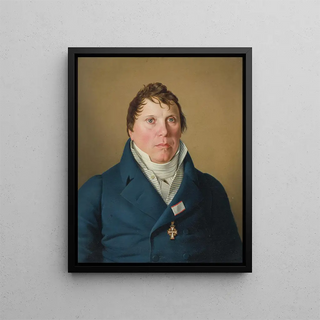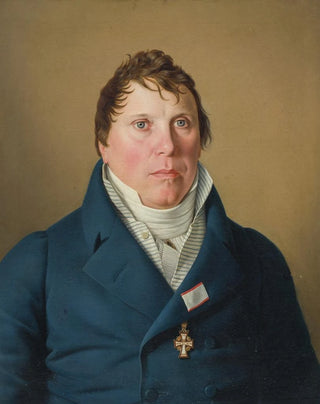Painting The Danish governor Lund - Christoffer Wilhelm Eckersberg | Art print


View from behind

Frame (optional)
In the fascinating world of art, some works transcend their era to capture the essence of a culture and society. "The Danish Governor Lund" by Christoffer Wilhelm Eckersberg is a perfect example. This painting, depicting a moment from daily life in Denmark in the 19th century, invites us to immerse ourselves in a world where the rigor of portraiture blends with an atmosphere of dignity and respect. Through this piece, Eckersberg does not merely portray a man in a position of power; he offers a reflection on Danish national identity at a pivotal time. The delicate light caressing the governor's features and the carefully composed background testify to exceptional craftsmanship and rare artistic sensitivity.
Style and uniqueness of the work
Eckersberg's style is distinguished by meticulous precision and attention to detail that bring each element of the composition to life. In "The Danish Governor Lund," the chosen color palette evokes an ambiance that is both solemn and warm. The shades of blue and brown, dominating the piece, create a harmonious contrast and highlight the governor's face, whose expression is imbued with wisdom and firmness. The drapery of his clothing, carefully rendered, adds a tactile dimension to the painting, almost palpable. This technical mastery, combined with a balanced composition, makes this work a true masterpiece of realism. Eckersberg manages to capture not only the physical appearance of the character but also his essence, status, and role within Danish society of his time.
The artist and his influence
Christoffer Wilhelm Eckersberg, often regarded as the father of Danish realism, played a decisive role in the evolution of art in Denmark. Trained at the Royal Danish Academy of Fine Arts in Copenhagen, he was influenced by the great European masters, while developing a style that was uniquely his own. His work not only marked his era but also paved the way for many artists who followed in his footsteps. Eckersberg successfully integrated elements of nature and everyday life into his

Matte finish

View from behind

Frame (optional)
In the fascinating world of art, some works transcend their era to capture the essence of a culture and society. "The Danish Governor Lund" by Christoffer Wilhelm Eckersberg is a perfect example. This painting, depicting a moment from daily life in Denmark in the 19th century, invites us to immerse ourselves in a world where the rigor of portraiture blends with an atmosphere of dignity and respect. Through this piece, Eckersberg does not merely portray a man in a position of power; he offers a reflection on Danish national identity at a pivotal time. The delicate light caressing the governor's features and the carefully composed background testify to exceptional craftsmanship and rare artistic sensitivity.
Style and uniqueness of the work
Eckersberg's style is distinguished by meticulous precision and attention to detail that bring each element of the composition to life. In "The Danish Governor Lund," the chosen color palette evokes an ambiance that is both solemn and warm. The shades of blue and brown, dominating the piece, create a harmonious contrast and highlight the governor's face, whose expression is imbued with wisdom and firmness. The drapery of his clothing, carefully rendered, adds a tactile dimension to the painting, almost palpable. This technical mastery, combined with a balanced composition, makes this work a true masterpiece of realism. Eckersberg manages to capture not only the physical appearance of the character but also his essence, status, and role within Danish society of his time.
The artist and his influence
Christoffer Wilhelm Eckersberg, often regarded as the father of Danish realism, played a decisive role in the evolution of art in Denmark. Trained at the Royal Danish Academy of Fine Arts in Copenhagen, he was influenced by the great European masters, while developing a style that was uniquely his own. His work not only marked his era but also paved the way for many artists who followed in his footsteps. Eckersberg successfully integrated elements of nature and everyday life into his
12,34 €






